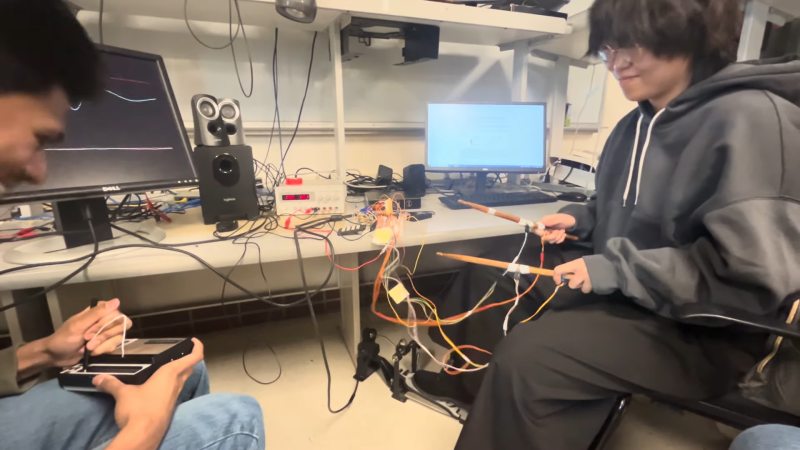Drum kits are excellent fun and a terrific way to learn a sense of rhythm. They’re also huge and unwieldy. In contrast, air drums can be altogether more compact, if lacking the same impact as the real thing. In any case, students [Ang], [Devin] and [Kaiyuan] decided to build a set of air drums themselves for their ECE 4760 microcontroller class at Cornell.
As per the current crop of ECE4760 projects, the build relies on the Raspberry Pi Pico microcontroller as the brains of the operation. The Pico is charged with reading the output of MPU6050 inertial measurement units mounted to a pair of drum sticks. The kick pedal itself simply uses a button instead.
Where the project gets really interesting, though, is in the sound synthesis. The build doesn’t simply play different pre-recorded samples for different drums. Instead, it uses the Karplus-Strong Drum Synthesis function combined with a wavetable to generate different sounds.
In the demo video, we get to hear the air drums in action, complete with a Stylophone playing melody. Unlike some toy versions that trigger seemingly at random with no rhythm, these air drums are remarkably responsive and sound great. They could be a great performance instrument if designed for the purpose.
We’ve seen similar builds before, too.
















A longer demo would have been nice, but that’s surprisingly good, given the obvious limitation that the sticks aren’t hitting anything and so don’t rebound properly.
After the near silence of distant speech the demo was good. After untangling wires or having little pins come out against strong motions that took longer than the demo meh. Bundle it all in 2 jacketed cables of high flexibility and going to hand grips with the wire on the wrist side and it’s a hit. Drumroll! Cymbal splash!
Now integrate with IMU or kinect tech, for a full kit.
You do realize this is a demo of a class project, right? Not a kit, right?
The prof graded us on neatness and practicality as well as presentation. We couldn’t have the St Louis Arch or the Brooklyn Bridge style jumpers on a breadboard, they had to lay flat and straight.
This is severely cool. It’s too bad Rowan Atkinson perfected the technology already
https://youtu.be/A_kloG2Z7tU?si=aSqZY_dKyLCD0a_X
So great. It’s amazing how well this works for how simple it is — which indicates some good thinking and probably no end of fine-tuning behind the scenes.
Also: Stylophone!